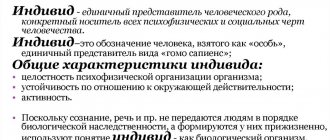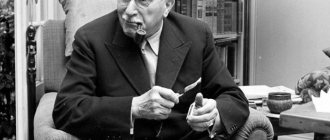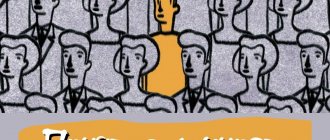Personality theory A.N. Leontyev
Author D.A. Leontyev. Source Psychology OnLine.Net
If in Western psychology the formation of personality psychology can be dated back to the end of the 1930s, when the first generalizing books on personality by K. Lewin, G. Allport and G. Murray were published, then in our country this issue for a long time was actually closed to real research due to its increased ideological sharpness, together with such disciplines as psychodiagnostics, psychotherapy, social psychology and sociology - their “unfreezing” began only in the late 1960s, when a serious conversation about personality in the humanities became possible again. Previously, in textbooks for pedagogical institutes, sections on personality were limited to general words; personality, in fact, was reduced to character, and character to temperament and other individual typological characteristics; such a characteristic of personality as its orientation was actually reduced to the ideological parameter individualism-collectivism.
Almost the first domestic book in which personality problems were revealed professionally, and not through ideological idle talk, was I.S. Kon’s book “Sociology of Personality” (Kon, 1969), and issues of personality psychology began to come to the fore only in the 1980s .
One of the few original domestic approaches, which can be legitimately considered as a relatively holistic independent psychological theory of personality, is the theory of A.N. Leontiev. All of his publications on personality psychology fit into a very short period of time - in fact, five years. The first publication on this topic was a small article “Some psychological issues of influence on personality” (Leontyev, 1968); soon after this, the famous chapter “Activity and Personality” was written, which was first published in a magazine version, and then included in the book “Activity. Consciousness. Personality" (Leontyev, 1974; 1975). It is what is now known as the personality theory of A.N. Leontiev. However, the relatively recently published “Methodological Notebooks” from the archives of A.N. Leontiev, dating back to approximately 1940, but published only 15 years after the death of the author (Leontiev, 1994), contain in abstract form almost all the ideas that formed the basis for the basis of publications in the 1970s. Their publication was impossible for many years, but their very presence refutes the first impression that Russian personality psychology lags far behind Western psychology.
In his relatively short texts, A.N. Leontiev, of course, could not develop a theory of personality in all its details. However, he managed to build a fairly harmonious and logically coherent framework of personality theory, which served as the basis for the work of a number of his students, whose names are now primarily associated with Russian personality psychology. The most notable contribution to the development of this area of work over the past three decades was made by A.G. Asmolov, B.S. Bratus, F.E. Vasilyuk, B.V. Zeigarnik, V.A. Petrovsky, E.V. Subbotsky.
Personality as a special reality
From the very beginning, Leontiev introduces in these notes a fundamental departure from the views of most of the psychologists of his time.
“In the ordinary, everyday understanding,” writes A.N. Leontiev in “Methodological Notebooks” (1994, p. 194), “this is what controls individual processes of activity and behavior. This is the “master” of the processes.” Leontyev emphasizes that we are talking about everyday understanding. In fact, this is not so: personality is not a special quality or interconnection of mental processes, it has a different nature: “the problem of personality is the problem of unity, the interconnection of individual activities” (Leontyev, 1994, p. 194; emphasis added – D.L.) .
The difference between these formulations is very significant. The interconnection of mental processes is what relates to mental reality. Thus, we bring the personality under the general category of the psyche; personality turns out to be one of the structures of the psyche. A.N. Leontyev, on the contrary, fundamentally takes the concept of personality beyond the concept of the psyche into the plane of relations with the world; as he formulated later, “the problem of personality forms a new psychological dimension: different from the dimension in which studies of certain mental processes are conducted” (Leontyev, 1983, p. 385). This position, coming from Vygotsky, fundamentally distinguishes the approach of A.N. Leontyev from the views of A.F. Lazursky, S.L. Rubinstein, V.S. Merlin and almost all other domestic and foreign authors. According to the ideas of A.N. Leontyev, personality is a special reality that deserves a special subject, “personality is not a simple biological unity, it is a higher unity, historical (social) in nature. This unity - personality - is not given initially. Man is not born as an individual. A person’s personality arises in the course of the development of his life” (1994, p. 195).
Leontiev, thus, defines personality as a connection, a hierarchy of activities, and not mental processes. “The individual becomes a personality... in the course of his biography. In this sense, personality is a “clump” of biography” (Leontyev, 1994, p. 196). In other words, personality is not biological or social, not conditions or factors, but biography, life experience! Personality is the result of the “crystallization” of biography. This is the first thesis of A.N. Leontyev.
The second thesis: personality develops, i.e. There are qualitatively special stages of personality development that are not related to the development of mental processes.
The third thesis is that personality has a structure. From the very beginning, a separation of the individual and the personality is introduced. If an individual represents a kind of biological unity, a connection between natural organs and their functions, then personality is a non-biological unity. It gradually arises, is formed in the course of life, therefore there is the structure of the individual, and there is a personality structure independent of him.
In fact, the same general idea, albeit in slightly different words, is reproduced more than three decades later in the book “Activity. Consciousness. Personality." Leontyev begins his analysis of personality by stating the important thesis that personality is not everything in a person. There is also something that has nothing to do with the personality, there is something that does, but it is not known in advance. “The same characteristics of a person can stand in different relationships to his personality” (Leontyev, 1975, p. 165). Our task, writes A.N. Leontiev, “requires understanding personality as a psychological new formation that is formed in the life relationships of the individual” (ibid., p. 172). Everything else - natural and social - are prerequisites for the development of personality, from which development itself cannot be deduced.
Personality first arises when a person enters history, and he becomes a person only as a subject of social relations. “A person’s personality is in no sense pre-existing in relation to his activity, just like his consciousness, it is generated by it” (ibid., p. 173).
A.N. Leontiev’s position on personality as an “internal moment” of activity caused a lot of criticism, in which he was reproached for allegedly reducing personality to activity, depriving it of its specificity. However, Leontyev never said that personality is only a moment of activity. The meaning of this thesis is that activity has a “subject-object” structure; it cannot be carried out without a subject, who is a person. Activities are constituted by motives, and motives are associated with the personality, but not with the individual.
Personal development. Personality and biography
An individual is a connection of natural organs and their functions, which arises on the basis of differentiation and at the same time integration of living patterns. This is a connection of natural needs that determines the natural hierarchy of activity. Personality, on the contrary, is “a connection and hierarchy of activities determined not biologically, but historically” (Leontyev, 1994, p. 196). It is determined by the process of differentiation of activities and their resubordination, new hierarchization, new, secondary, higher connections arise.
This thesis clearly shows continuity with Vygotsky’s line. According to his views, along with natural functions there are higher human functions. They arise during life, become individual, move from interpersonal space to intrapersonal space (this is the essence of the process of internalization). Personality is formed in the process of individual history, in the process of communication with other people.
This is followed by the paragraph “Phylogenesis of Personality”. “The initially emerging personality...,” writes Leontyev, “is not yet an individual personality. People in a primitive tribal society... have not yet broken away... from the umbilical cord of primitive society" (ibid., p. 197). They form a certain unified integrity. Historically, personality develops as the separation and autonomization of individuals from the primary aggregate personality. Initially, a community, a social group represents a single personality, then gradually an autonomous individual crystallizes from it (see Leontyev D.A., 1989).
The following fundamental thesis characterizes the direction of personal development: “From “acting to satisfy one’s natural needs and drives” to “satisfying one’s needs in order to act, do the work of one’s life, fulfill one’s life’s human goal” (Leontyev, 1994, p. 198) . The cause-and-effect structure turns around: first actions for needs, then needs for actions.
A.N. Leontyev further speaks about inclinations as conditions and prerequisites for the development of personality, which influence what has become, but do not predetermine it. The inclinations themselves change throughout life, and abilities are formed on the basis of inclinations, but abilities are truly created only in activity, and while there is no activity, they remain inclinations. In the late 1950s - early 1960s, there was a discussion in the psychological literature on the problem of abilities between B.M. Teplov, A.N. Leontyev and S.L. Rubinstein. The essence of the discussion was what exactly to call abilities, what this term refers to: either to inclinations that have not yet manifested themselves, or to what has manifested itself and been formed in activity. A.N. Leontyev argued that inclinations do not yet determine anything, therefore the concept of abilities is correctly attributed to already formed operational skills. B.M. Teplov, on the contrary, considered individual innate inclinations to be true abilities, in contrast to operational skills. S.L. Rubinstein also disagreed with A.N. Leontiev, believing that operational activity structures are not at all included in the subject of psychological study.
What determines a person’s personality, A. N. Leontiev asks himself, and writes: “not internal conditions taken by themselves, nor external conditions, nor just a combination of both. Personality is the process that “connects” them with each other” (Leontyev, 1994, p. 200). And very briefly: “Personality is determined by life” (ibid.).
A.N. Leontiev’s views on personality development are also reproduced in his publications of the 1970s, but with significant additions. The concept of personality, he notes, expresses the integrity of properties that are formed in the process of ontogenesis, that is, integrity is not predetermined, unlike the individual, but is becoming. “Personality is a relatively late product of the socio-historical and ontogenetic development of man” (Leontyev, 1975, p. 176). A. N. Leontiev’s metaphor about two births of personality is well known. Personality “is born twice: the first time - when the child manifests in obvious forms the polymotivation and subordination of his actions, ... the second time - when his conscious personality arises” (ibid., p. 211). The first birth coincides with the crisis of three years, when for the first time hierarchization and subordination of actions and delay of gratification arise. The second birth is with the teenage crisis, when mastery of one’s own behavior occurs through awareness and mediation. We can say that these two “births of personality” represent critical points in the progressive emancipation of the personality from symbiotic relationships. “The first birth of personality” is the operational emancipation of the personality, when the child feels himself as a kind of autonomous unit; “second birth” is semantic emancipation, awareness of oneself as a semantic unit, when a teenager’s worldview becomes individual and ceases to coincide with the semantic field in which he was formed (Leontyev D.A., 2002).
At the end of the chapter, A.N. Leontiev introduces a fundamentally important idea of the internal work of the individual. “At every turn in life’s path, he (a person) needs to free himself from something, to affirm something in himself” (1975, p. 216). A person is, to a certain extent, a crystallization of a biography, but it is impossible to consider a person completely the result of a biography, because this misses the main psychological fact - “a person enters into a relationship with his past, which in different ways enters into what is available to him - into the memory of his personality” ( ibid., p.217). At the level of the individual, past impressions do not act as quiescent layers of his experience; in this past, one thing dies, loses its meaning, another opens up in a new meaning. These changes happen constantly; the past can be revalued and a person “throws off the burden of his biography” (ibid.). In doing so, he takes a significant step forward compared to what he wrote in 1940.
Of course, a person is to a certain extent a crystallization of his biography, but it is wrong to consider a person entirely a product of his biography. On the one hand, personality is formed in the process of life, biography, on the other hand, it is not only the result of what happens, but also the result of what a person makes of himself. “Like the past, the future is present in the individual. The life perspective that is revealed to a person is... his property” (ibid., p. 218).
Personality structure
“Methodological Notebooks” also contains everything that in the 1970s became known as the concept of the personality structure of A. N. Leontiev, although Leontiev so far speaks more not about the hierarchy of motives, but about the hierarchy of activities. Personality, according to A.N. Leontiev, is characterized, firstly, by “the wealth, the diversity of the actual relationships of the subject that make up his life. This is the foundation, the real basis of the personality” (Leontyev, 1994, p. 201). Leontyev, however, makes a reservation: not every actual human activity is part of his life. Certain activities may become alienated from a person. We do a whole series of things that may have nothing to do with our life, but may be something external to it.
The second characteristic is “the degree of development of “secondary”, higher connections of actions (motives) among themselves - their hierarchization. “This is precisely the degree of development of the individual” (ibid., p. 202), its genetic characteristics. Thus, the vector of personality development is at the same time a vector of its hierarchization and ordering. This idea echoes the personality theories of a number of authors, such as G. Allport, S. L. Rubinstein, K. Levin, K. G. Jung. And the third characteristic is the type of personality structure: monovertex, polyvertex, etc., that is, we mean the general structural profile. Not every motive or life goal is capable of becoming the pinnacle, of bearing the entire load of the pinnacle of personality. They say that while giving lectures on personality psychology in the 1970s, he said that in fact there is not a pyramid with a wide base at the bottom and tapering upward, towards the highest life goal, but rather, on the contrary, an inverted pyramid standing at the top - the life's purpose bears all its burden. And it will depend on what the main life goal, the leading motive is, whether he will withstand the entire structure on himself or not. The leading motive of a person must be such as to support the entire structure.
Quite a lot is said in the “Methodological Notebooks” about the problem of meaning, in the context of regulation of activity, in the context of consciousness, in particular, in line with the formula “development of life = development of motivation = development of meaning” (ibid., p. 210). It is through meanings that psychology connects with specific history. “Psychology has become the science of personality - a real personality, acting, affirming its life. Psychology now merges with the problems of human ethics... Therefore, the doctrine of activity is the alpha, the doctrine of meaning is the omega of psychology!” (ibid.).
A separate paragraph is devoted to consideration of the problem of character. A.N. Leontiev clearly distinguishes between character in the broad and narrow sense of the word. By character in a broad sense, he understands almost all individual differences, everything that characterizes a person does not allow him to be confused with another. Character, personality, individuality - these three words, with this understanding, actually express the same thing. A.N. Leontiev does not define character in the narrow sense of the word, but points out that “only this use of the term “character” in psychology is justified” (Leontiev, 1994, p. 201).
The interpretation of character not as a synonym for personality, but as its private substructure was disclosed in a number of works in the 1980-1990s (A.G. Asmolov, B.S. Bratus, D.A. Leontyev, etc.).
If in 1940 A.N. Leontyev wrote about personality as a hierarchy of activities, then in the works of the 1970s. he simplifies this construction a little - since activity is determined by motive, personality can be described more simply as a hierarchy of motives. A.N. Leontiev describes the personality structure as a hierarchy of motives, “a relatively stable configuration of the main, internally hierarchized, motivational lines” (Leontiev, 1975, p. 221). Analyzing this position, it is necessary to understand that by the concept of motive, different authors mean Different things. On the one hand, the motive is interpreted as a situational stimulant of specific activity (A.G. Asmolov, S.D. Smirnov), on the other hand, as something stable and generalized, rooted in the structure of the personality (V.A. Ivannikov, H. Heckhausen ). We are not talking about radical differences in explanatory models, but about the fact that the term “motive” is assigned in some cases to some, and in others to other elements of this model of the incentive structure (see more details Leontyev D.A., 2004). A.N. Leontiev himself used the concept of motive in both meanings, without dividing them. Many of the new concepts that he introduced into his apparatus are undifferentiated, and the same word refers to different things that were differentiated later. Thus, when he characterizes personal meaning as the relationship of a motive to a goal or speaks of the incentive and meaning-forming functions of a motive, he means the motive of a specific activity unfolding at a given moment; when he talks about the hierarchy of motives as the basis of the personality structure, he obviously means generalized motivational formations.
A.N. Leontyev identifies three main parameters of personality: “the breadth of a person’s connections with the world, the degree of their hierarchization and their general structure” (ibid., pp. 223-224). Here he essentially reproduces, with some clarifications, the structural model that was sketched out in the Methodological Notebooks.
One of the most interesting aspects of A.N. Leontiev’s theory of personality is the analysis of what happens as a result of the “second birth of personality.” First of all, there is a mastery of one’s behavior, the formation of new mechanisms for resolving motivational conflicts associated with will and consciousness. “Only an ideal motive, i.e. a motive that lies outside the vectors of the external field is capable of subordinating actions with oppositely directed external motives” (ibid., p. 209), i.e. act as a mediating mechanism for mastering one’s behavior, resolving the conflict in the external field, resolving that same Buridan conflict. It is in the imagination, A.N. Leontyev believes, that we can find and build something that will help us master our own behavior. “The psychological mechanisms of life as a feat must be sought in the human imagination” (ibid.), because the feat is determined by a motive that is not in the external field, and a person transcends the immediate field, enters another layer of reality, which allows him to act independently in relation to to the current external field. This is the act that A.N. Leontiev defined in his “Methodological Notebooks” as “an action whose fate is not determined by the current situation” (1994, p. 182).
Theory of A.N. Leontiev and existential psychology
It was this last side of the personality that most occupied the thoughts of A.N. Leontiev in the last years of his life, and their most concentrated expression was handwritten notes published posthumously under the title “On the subject of personality psychology” (A.N. Leontiev, 1983, p. 384-385). “The problem of personality forms a new psychological dimension: other than the dimension in which research is carried out on certain mental processes, individual properties and states of a person; this is a study of his place, position in the system, which is a system of social connections, communications that open to him; this is a study of what, for what and how a person uses what is innate to him and acquired by him” (ibid., p. 385). Even earlier, A.N. Leontyev wrote: “Personality... appears as what a person makes of himself, affirming his human life” (1975, p. 224).
In fact, these formulations, summing up and as strictly as possible formulating the novelty of A.N.’s approach. Leontiev’s approach to personality, express an existentialist position on the issue of the relationship between personality and factors or prerequisites for its development. Indeed, in recent years a number of students of A.N. Leontiev noted the closeness of his approach to existentialist views in psychology. E.V. Subbotsky (2003) directly calls him “an existentialist in Soviet psychology” (p. 186), F.E. Vasilyuk (2003) states that through the principle of objectivity A.N. Leontyev “potentially introduced the phenomenological category of the “life world” into domestic psychology” (p. 239), A.G. Asmolov (2003) calls the activity approach “the psychology of existence.” But this similarity is also noticed by representatives of existential-phenomenological psychology. A.G. Asmolov recalled that when the German translation of the book “Activity. Consciousness. Personality", A.N. Leontiev received a letter from Hans Thome, a prominent West German psychologist of existential-phenomenological orientation. Tome wrote to Leontiev: how wonderful it is that in the Soviet Union the traditions of existential-phenomenological thinking are developing and continuing. Recently, the famous psychotherapist Alfried Längle, a student of V. Frankl, who spoke at the Faculty of Psychology of Moscow State University, stated the same thing in the guest book of the Department of General Psychology: “Here in Moscow you have more traditions of existential psychology, and you go even further in this than in Austria and Germany. You are our hope” (Quote: Bratus, 2003, p. 13).
Existential psychology and philosophy are related to activity theory by a key principle, which was succinctly formulated by J.-P. Sartre: “Existence precedes essence.” In the activity approach, a similar principle states that all mental and personal structures initially exist as structures of activity, being realized in real relations with the world, only after that they crystallize in the form of some stable structures. For A.N. Leontiev, starting from the 1940s, activity, first of all, is a form of interaction with the world, and then with everything else. And this interaction itself is not derived from something else - traits, motives, dispositions - on the contrary, the structures of the psyche, consciousness and personality are derived from it. Both innate and acquired turn out to be only raw materials, clay, tools; neither the biological nor the social defines personality; they are “equidistant” from the personality, which cannot be reduced to either one or the other. “The “center of personality,” which we call “I,” ... lies not in the individual, not behind the surface of his skin, but in his being” (Leontyev, 1975, p. 229).
Literature
- Asmolov A.G. Non-activity paradigm in thinking of the 21st century: activity as existence // World of Psychology, 2003, No. 2(34), p. 155-158.
- Bratus B.S. Logotherapy as the art of being // Langle A. Life filled with meaning: Applied logotherapy. M.: Genesis, 2003, p. 5-13.
- Vasilyuk F.E. “You understand...” // Journal of Practical Psychologist, 2003, No. 1-2, pp. 232-240.
- Kon I.S. Sociology of personality. M.: Politizdat, 1969.
- Leontyev A.N. Some psychological issues of influence on personality // Problems of scientific communism. M., 1968, issue. 2, p. 30-42.
- Leontyev A.N. Activity and personality // Questions of philosophy, 1974, No. 4, p. 87-97; No. 5, p. 65-78.
- Leontyev A.N. Activity. Consciousness. Personality. M.: Politizdat, 1975.
- Leontyev A.N. Selected psychological works in 2 volumes. M.: Pedagogy, 1983, vol. 1.
- Leontyev A.N. Philosophy of psychology: from the scientific heritage. M.: Publishing house Mosk. University, 1994.
- Leontyev D.A. Personality: man in the world and the world in man // Issue. psychol., 1989, No. 3, pp. 11-21.
- Leontyev D.A. Symbiosis and adaptation or autonomy and transcendence: personal choice in an unpredictable world // Personality in the modern world: from a strategy of survival to a strategy of life creativity / ed. E.I. Yatsuta. Kemerovo: IPK “Graphics”, 2002, p. 3-34.
- Leontyev D.A. General idea of motivation // Psychology at university, 2004, No. 1. P.
- Subbotsky E.V. “Alexey Nikolaevich... was actually an existentialist in Soviet psychology” // Journal of Practical Psychologist, 2003, No. 1-2, p. 181-198.
Domestic psychology
Russian psychology is permeated with the idea of the relationship between man and the world.
Theory of N. A. Berdyaev
According to the concept, the individual cannot be identified with society. Society is part of the individual. The personality itself is an ethical and spiritual category. Each personality contains something common to all people and something different.
There is a degree of mysticism in the perception of personality as something spiritual, but this theory served as the basis for many current provisions about the phenomenon of man as a personality.
The theory of relations by V. N. Myasishchev
According to the concept, a person as an individual is characterized through a system of conscious relationships. The author highlights a person’s attitude to the world of nature and things, people and society, to himself as an individual. At the same time, the system of relations is subordinated to a certain hierarchy, which reflects the significance of the objects of relations for a person.
At the same time, any human relationship is endowed with the following characteristics:
- arises, develops, takes shape and disintegrates in the process of human life;
- always expresses the personality as a whole;
- meaningful (has a subject);
- at a certain level consciously;
- is of a direct or indirect nature (related to a process or place);
- related to needs;
- has three aspects (volitional, cognitive, emotional);
- selectively;
- generalized to varying degrees;
- differs in significance and sustainability.
The author brought relationships with people to the fore.
The development of any relationship, that is, the personality itself, is influenced by upbringing and self-education based on innate characteristics, as well as the social conditions of development and the conscious activity of a person.
Theory of V. S. Merlin
Merlin continued Myasishchev’s theory, but differentiated the concepts of “attitude” and “personal attitude,” or mental properties. In the author’s concept it sounds like this: “Personal properties are only those properties in which personality relationships are expressed.”
The author was one of the first domestic researchers to consider personality as a unity of properties, and not a collection of individual elements. As a result, the psychologist noted the generality, activity and stability of the relationship. These are characteristics that are responsible for exactly how and how quickly the symptom complex (certain interrelated personality properties) changes depending on changes in external conditions.
The author determined that the integrity of the individual depends on the equal development and influence of 3 factors (motives):
- ideological orientation;
- desire for self-expression;
- satisfaction of material needs and organic drives.
This approach is useful in studying the nature of neuroses, character disorders, personality and mental disorders.
The "bittersweet" phenomenon
A. N. Leontiev’s theory demonstrates this using the phenomenon of “bitter” candy. Thus, in the experiment, the child was asked to perform a obviously impossible task. For example, getting something from where he is sitting. It was impossible to do this without getting up. For this, the child was promised candy. After which the experimenter leaves the room, provoking the child to break the rules, which he does. Then the experimenter enters the room and gives the child the well-deserved candy. But the child refuses her and begins to cry. This is where the motivational conflict manifests itself: to be honest with the experimenter or to receive a reward. The main motive here was an attempt to be honest.
Difference between concepts
Leontiev's theory distinguishes between the definitions of the terms “individual” and “personality”.
An individual is an indivisible, holistic formation determined by hereditary factors with its own specific characteristics. Specific characteristics are understood as characteristics that arose both as a result of heredity and as a result of adaptation to the natural environment: physical structure, temperament, eye color, etc.
The concept of personality is applicable only to a person and not from his birth, that is, a person must still become one. Until about two years of age, a child does not yet have a personality. Thus, a person is not born, but becomes.
It, in turn, begins to form when the child enters into social relations, into relationships with other people. Personality is a holistic formation, but not acquired, but produced, created as a result of the interconnection of a large number of objective activities. The child develops cultural forms of behavior, and his psyche becomes different. The emphasis in Leontiev’s theory of development is on how the subject’s motives change under the influence of culture, because the child develops many new social motives.
Motives arise in connection with the demands that society places on him. Many new motives form a hierarchy: some are more significant, while others are less significant. Leontiev's theory of personality connects its emergence with the formation of a stable hierarchy of motives. This hierarchy appears at the age of three or four years. The child’s personality begins to develop through relationships with the world around him and the objects in it. Initially, children study the physical properties of objects, and then their functional purpose, which is used in activities. For example, a child looks at a glass and holds it, and then understands that it is needed to drink, and therefore to carry out a specific activity. Thus, the stage of objective-practical activity moves on to the assimilation of the hierarchy of activities at the level of social relations.









